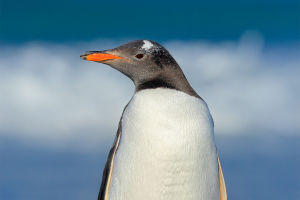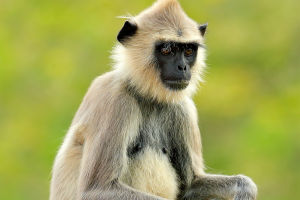The red-crowned crane has snow-white primary feathers with a black face and neck. White feathers extend from behind the eyes to the nape, and a red patch tops the crane's head, giving it its name. The majority of it's body is pure white .
The red-crowned crane has a deep green bill and a long, sharply angular beak for spearing its prey. Both males and females are the same color, and males tend to be slightly larger.
The red-crowned crane juveniles have a combination of white, partly tawny, cinnamon brown and/or gray plumage. It's neck collar is gray to coffee brown, the secondary feathers are dull black and brown, and the crown and forehead are covered with gray and tawny feathers.
It's legs and bill are similar to those of adults but lighter in color. The primary feathers are white, tipped with black, as are the upper primary coverts. At two years of age, the bird's primary feathers are replaced with all white feathers.
Red-crowned cranes are semiaquatic, so they are found wherever there is an abundance of water. Because they are omnivorous, they not only fish and hunt for small amphibians and rodents, but they also feast on reeds and other marsh plants. They are often associated with cold-weather climates.
Though they tend to stick to regions with milder climates. They also live in the much warmer climates of southeastern Asia.
These birds are known to be monogamous: They often find one partner and mate for life. This may be why they symbolize loyalty in Asian cultures. When a couple is together, they use their long windpipes to vocalize with a unison call, which strengthens their bond. They also mate by dancing, gracefully leaping into the air or even bouncing like a ball.
Red-crowned cranes are active and social. They also call and dance to warn each other to stay away, or even to play. During the day, they go out on their own, in pairs, or in groups. At night, they usually come together to roost. This is why they often live in colonies, or flocks.
The omnivorous birds seek out sustenance in marshes and feeds on a variety of invertebrates and small aquatic invertebrates, fish, amphibians, rodents, reeds, grasses, heath berries, corn and other plants. In the winter, they move to paddy fields where they feed on rice.
During the winter,they are fed on corn at artificial feeding stations. Cranes in managed populations are fed crane pellets, mealworms, earthworms, crickets and small fish.
Red-crowned crane's nests are built on wet ground or in shallow water. Females usually lay two eggs, and incubation (by both sexes) lasts 29 to 34 days. The male takes the primary role in defending the nest against possible danger. Chicks fledge, or take their first flight, at about 95 days.
When the young cranes are three months old, they accompany their parents while looking for food in the wetlands. They are able to fly by autumn. Families stay intact until the next breeding season when the young adults leave the parents.
The red-crowned crane is the second-rarest crane in the world—second only to the whooping crane in North America. It is an endangered species, with only 1,830 adults in the world and dropping.
The most obvious reason is loss of habitat, as the wetlands where these cranes’ breeding grounds are shrinking and are now often too small to sustain the species.
Human activity and a natural dry spell are the main culprits of this habitat loss.So we need to take various measures to protect the red-crowned cranes, and our protection of the environment is stronger than before.


